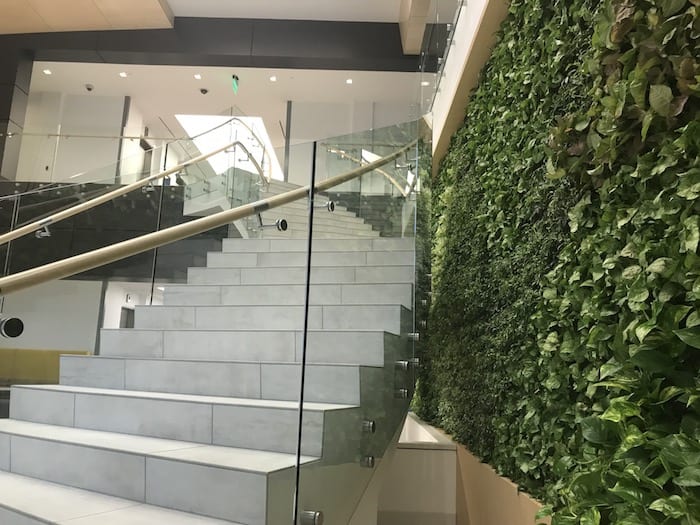Reconnecting People with Nature: Green Walls

BUILDING DIALOGUE
Humans have a natural disposition to seek and to connect with nature and other forms of life. But people living in urban areas are becoming more disconnected from nature. Plant walls are an easy and stunning way to reconnect them to nature. Plant walls can improve people’s health and mood. A living wall can be a breathing piece of art, and it can create large visual relaxing areas of nature in the built environment. Most living walls put vegetation at eye level for maximum viewability and natural connectivity. Plant walls also improve air quality, help reduce background noise (planted surfaces have low noise reflectivity and high absorption properties) and reduce dust in interior space (large areas of greenery help to minimize dust partial).
There are also some environmental benefits. When a business chooses to install a green wall, it is reinforcing its commitment to sustainability and environmental issues. Green walls also stand out in urban environments, providing visual appeal, creating interest and increasing commercial returns. A green wall has the potential to turn a building into a local landmark. When done right, living walls can increase property value. With sustainable design and an improved carbon footprint being contemporary topics in the building industry, green walls are a desirable feature and may increase a property’s value. Both interior and exterior greenery have been shown to have a positive effect on real estate values.
Plant walls are a great way to reconnect people with nature, but it needs to be done right. To have a successful green wall, some factors will influence the overall success of a living wall.
You will need a complete system design. Living walls mimic nature, so they will need light, irrigation and nutrition. Another major factor to ensure a successful green wall is maintenance. You must include a maintenance plan to provide service after the project is complete. Work with a knowledgeable green wall supplier to set up a maintenance plan. Work with a supplier who is experienced in maintaining green walls since it takes different skills than maintaining regular office plants.
When looking to add a green wall to a space, the following considerations are important for determining a location for an indoor plant wall:
Will there be a lot of traffic where you will locate the wall? More maintenance may be required when living walls are easily accessible to the public. Minimize air blowing onto the wall. Airflow on the plants will tend to dry out sections of the wall unevenly and may result in increased maintenance visits. Avoid placement of indoor green walls near exterior doorways as this will subject the plants to temperature fluctuations and can be harmful to the plants.
Work with a knowledgeable green wall supplier who has expertise in sourcing plants based on location. Plant selection must also be matched to the particular green wall system and technology that is being installed. Not all species will grow well in each system. Rely on the expertise of the green wall supplier in this area as well.
Lastly, green walls are a long-term investment, so make sure your green wall supplier has local projects you can visit to make sure you like its work.
Published in the September 2018 issue of Building Dialogue. Contact the author at jpsijmons@cityplantscaping.com











